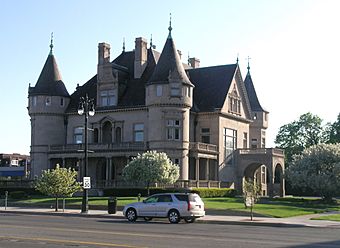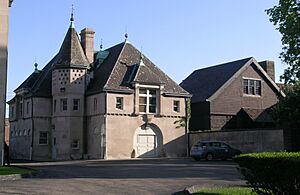Col. Frank J. Hecker House facts for kids
|
Col. Frank J. Hecker House
|
|
 |
|
| Location | 5510 Woodward Ave. Detroit, Michigan |
|---|---|
| Built | 1888–1892 |
| Architect | Scott, Kamper & Scott |
| Architectural style | Châteauesque |
| NRHP reference No. | 71000427 |
Quick facts for kids Significant dates |
|
| Added to NRHP | September 3, 1971 |
The Col. Frank J. Hecker House is a beautiful historic home in Detroit, Michigan. It was built between 1888 and 1892 for a successful businessman named Colonel Frank J. Hecker. You can find it at 5510 Woodward Avenue.
This special house was named a Michigan State Historic Site in 1958. It was also added to the National Register of Historic Places in 1971. Since September 2014, Wayne State University has owned the house.
Contents
Meet Colonel Frank J. Hecker
Frank J. Hecker was born in Freedom, Michigan, in 1846. When he was 18, he joined the Union Army during the American Civil War. He was a brave soldier and rose to the rank of Colonel.
After the war, Hecker worked for the Union Pacific Railroad. He used this experience to start his own company, the Peninsular Car Company, in Detroit. This company made railroad cars and helped him become very wealthy. His friend, Charles Lang Freer, whose house is right next door, was also part of this business.
Colonel Hecker served in the Army again during the Spanish–American War. He was in charge of moving Spanish prisoners. His work caught the attention of President Theodore Roosevelt. In 1904, President Roosevelt asked Hecker to join the Panama Canal Commission, which helped build the famous Panama Canal. Hecker also served as Detroit's Police Commissioner.
Discover the House's Architecture
In 1888, Frank J. Hecker hired the architectural firm of Scott, Kamper & Scott to design his new home. The house is located on Woodward Avenue, at the corner of Ferry.
This mansion is huge, with about 21,000 square feet of space. It is a great example of the French Châteauesque style. This style looks like the grand castles (châteaux) found in France. The Hecker House was inspired by the famous Château de Chenonceau in France. Colonel Hecker loved to host fancy parties here, and even presidents like William McKinley and Rutherford B. Hayes visited!
Exterior Features
The outside of the house has tall towers at its corners. It also has unique Flemish dormer windows on its steep roof. Several parts of the house stick out, adding to its interesting shape. A beautiful balustraded porch with columns wraps around the house.
Behind the main house, you can see a carriage house from Woodward Avenue. This building was once turned into a concert hall. It was big enough to seat 200 people!
Inside the Mansion
The inside of the Hecker House has 49 rooms!
- There's a large hall with oak wood panels, perfect for big parties.
- The dining room is oval-shaped and decorated with rich mahogany wood.
- The lobby is made of English oak.
- There's also a music room decorated in white and gold.
The fireplaces in the house are made from special Egyptian Nubian marble. The entryways feature beautiful onyx and Italian Siena marble.
Later Life of the Hecker House

Colonel Hecker lived in the house until he passed away in 1927. For the next 20 years, his family owned the home. During this time, it was used as a boarding house for college students.
In 1947, the mansion was sold to Paul Smiley. His company, Smiley Brothers Music Company, used it for music lessons and as a sales office. Many music groups, like the Detroit Chamber Music Workshop, started in this very building.
After Smiley died in 1990, a law firm bought the house. They carefully restored the mansion and used it as their offices until 2014. The house even served as the Royal Danish Consulate in Detroit for a while.
In September 2014, Wayne State University bought the house. The university plans to use it for activities related to its alumni (former students).
See also
 In Spanish: Casa del coronel Frank J. Hecker para niños
In Spanish: Casa del coronel Frank J. Hecker para niños

